
views
X
Trustworthy Source
PubMed Central
Journal archive from the U.S. National Institutes of Health
Go to source
You can make your own vegetable oils from many nuts and seeds with a home oil press. You can also make small amounts of avocado or coconut oil using common kitchen tools.
Using an Oil Press to Make Seed and Nut Oils

Purchase a manual oil press for making small batches. If you’re just interested in making small amounts (e.g., around 2 cups (0.47 L) or less) of oil now and then, a manual oil press or oil expeller is a good option. These presses are often hand-cranked and heated with a small kerosene or alcohol lamp. They typically come with a clamp that can be attached to your work surface (such as a table or counter). You can purchase oil presses online or from many home or kitchen supply stores. Manual oil presses tend to cost between $75 and $130 USD. You will need a separate container, such as a small glass jar, for catching the oil. Although these devices are often called “cold presses,” almost all forms of nuts and seeds require at least a small amount of heat (under 120 °F (49 °C)) to get them to release their oils.
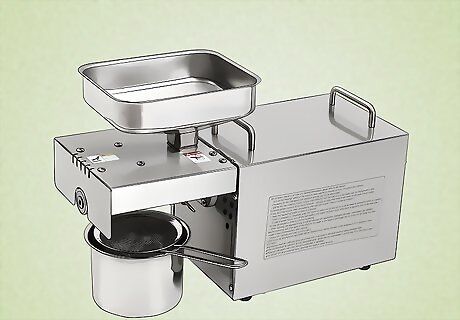
Buy an automatic oil press if you want to make larger batches. If you’re producing larger quantities of oil or want something easier and more efficient than a hand-cranked press, an electric oil press is your best bet. Search online for “electric oil press” or “automatic oil press.” Electric oil presses for home use are available from many online retailers and brick-and-mortar stores that sell kitchen appliances. These presses are costlier than old-fashioned manual presses, usually selling for around $200 to $500 USD.
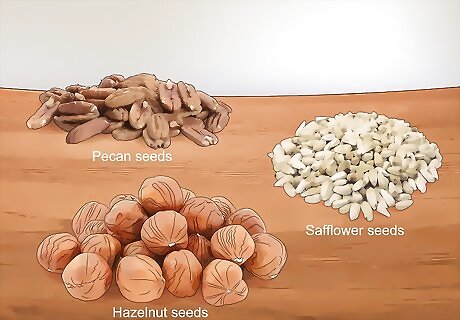
Select nuts or seeds with a high oil content. Check the instructions for your oil press to find out what oil content is required to make oil with that specific press. Most presses can extract oil from nuts or seeds with an oil content of at least 25%. Good nuts and seeds for making oil include: Sunflower seeds (be sure to use an oilseed variety). Pumpkin seeds (again, select oilseed pumpkins, which have shell-less seeds). Sesame seeds. Hazelnuts. Peanuts. Flaxseed. Safflower seeds. Pecans. Almonds. Walnuts.
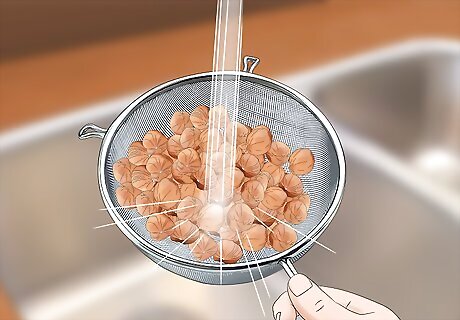
Clean your nuts or seeds and shell them if necessary. Rinse your seeds in water, taking care to remove any hard particles such as small stones, twigs, and dried-on dirt. These kinds of contaminants can get into the oil and even damage the press. For nuts and seeds with hard shells, such as walnuts and hazelnuts, it may be necessary to remove the shell before pressing the seeds. Check the instructions on your oil press to find out if nuts or seeds need to be shelled before pressing. For some presses, you may also need to chop up larger nuts before pressing them.
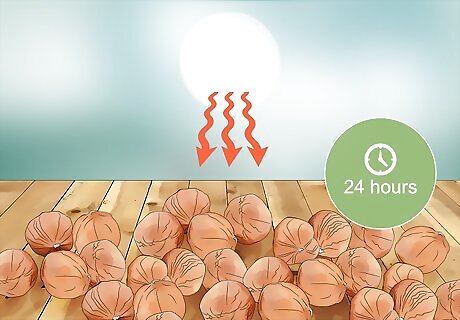
Sun-dry your nuts or seeds for 24 hours after cleaning them. Once your nuts and seeds are clean, lay them out on a cookie sheet and place them in a sunny spot to dry for a full day. Too much moisture in the seeds will prevent the oil from flowing properly during pressing. It may help your nuts or seeds dry more efficiently if you occasionally turn or stir them during the drying process. Another option is to dry the nuts or seeds on a screen propped up on supports (such as cinder blocks). This will allow air to circulate under the seeds as well as over them as they dry. If sun-drying isn’t an option, try putting your seeds in a food dehydrator. Follow the directions on your dehydrator for drying out nuts and seeds.

Warm up your oil press. If you’re using an electric press, follow the directions for warming your press before using it. Some presses may have different settings for warm- versus cold-pressing. If you’re using a hand-cranked press, you will need to light the heating lamp and let the press warm up for about 10 minutes before using it. Most manual press heating lamps use fuels such as kerosene or alcohol. You will need to light the wick with a match or lighter.
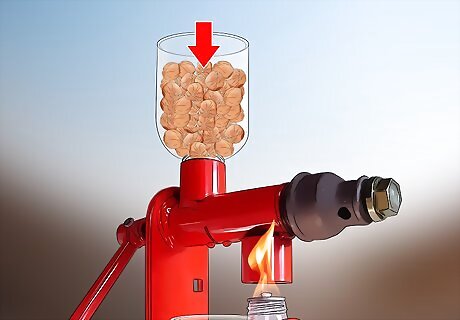
Add your nuts or seeds to the press as directed in the instructions. After your press is warmed up, pour your prepared nuts or seeds into the hopper or funnel at the top of the press. Make sure to read the directions to find out how many seeds or nuts your press can handle at a time. For some hand-cranked presses, you may need to make your own hopper out of a plastic water bottle with the end cut off.

Press the nuts or seeds according to your press’s directions. Once the nuts or seeds are inside the press, it’s time for the fun part! If you’re using an electric press, the press will do the hard work for you. For a manual press, you will need to slowly turn the crank to feed the seeds into the expeller. Make sure to place a reservoir under the machine to catch the oil as it comes out. If you use a manual press, a mason jar is a good option. Your press will also create seed cake, which is the crushed remnants of the seeds that you’ve pressed. If you like, you can save the seed cake for compost or chicken feed.
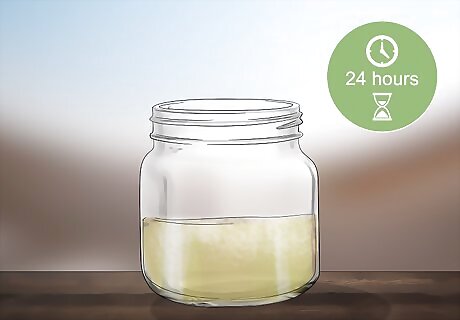
Let the oil settle for 24 hours. After you’ve extracted the oil, let it sit in a covered container for a full 24 hours. You will probably notice that your oil is cloudy or has particles floating in it. Letting the oil sit for a day will give these impurities time to settle to the bottom so that you can pour off the oil on top. Some electric presses have built-in filters. If your press filters out seed particles and impurities, just let your oil cool for a few hours before decanting it.

Put the oil into an airtight container and store it in a cool, dark area. Carefully pour the oil into a storage container, such as a jar or bottle with an airtight cap or cork. Take care not to let any of the fragments or impurities at the bottom of the jar flow into the new container. Seal the container and place it out of direct light in a place with cool, consistent temperatures (such as a kitchen cabinet or pantry). With proper storage, your oil may stay fresh for up to 2 years as long as you keep it sealed. Some seed oils, such as sesame, hazelnut, and walnut oils, will keep best if you put them in the fridge. If you don’t have an airtight container for storing your oil, use it within 2 to 3 days. If you notice that your oil has a strange smell, a stale taste, or a dark or cloudy appearance, then it may have gone bad. Dispose of any rancid oil or recycle it—for example, you can use it as lamp oil or lubricant for squeaky hinges, or make it into soap.
Making Avocado Oil
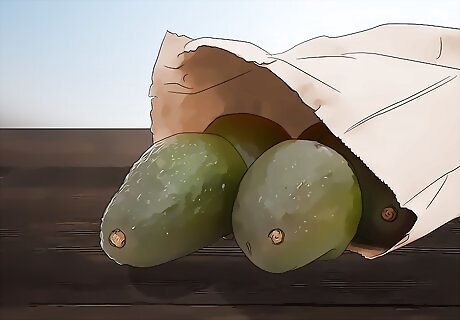
Select several ripe avocados. Look for avocados that are slightly soft or springy to the touch, but not mushy. You will be extracting the oil from the pulp of the avocado. Since 1 avocado will only yield about 1 tablespoon (15 mL) of oil or a little less, you will need a lot of avocados if you want a significant quantity of oil. Avocado oil has a lot of uses, including skin and hair care as well as cooking.
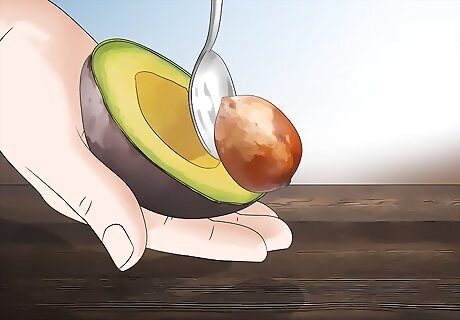
Cut open the avocado and remove the skin and seed. Use a kitchen knife to cut through the skin and pulp of the avocado, cutting around the large pit in the middle. Carefully pull the 2 halves of the avocado apart, then scoop out the seed and peel off the skin. You can either scoop the pit out with a spoon or twist it out with a sharp kitchen knife. To use a knife, push the sharp edge of the knife hard into the seed, then twist the knife 90°. The seed should pop out.
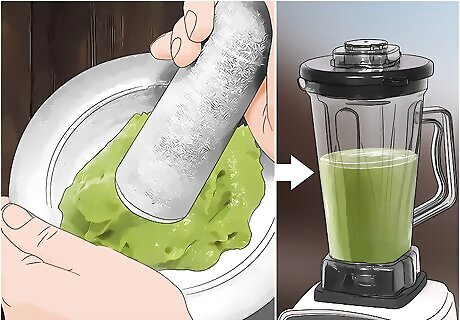
Blend the pulp into a paste. Once you’ve removed the pulp, mash it up with a potato masher or mortar and pestle. Then, place the avocado in a blender and mix it into a creamy paste. If you don’t have a blender, you can also use a cake batter mixer to blend the pulp. Add a little water if the pulp is too firm to blend easily. If you like, you can mix in a little bit of coconut oil at this point to help the avocado pulp release its oil more easily. If you used 12 avocados, put in about ⁄3 cup (79 mL) of coconut oil.
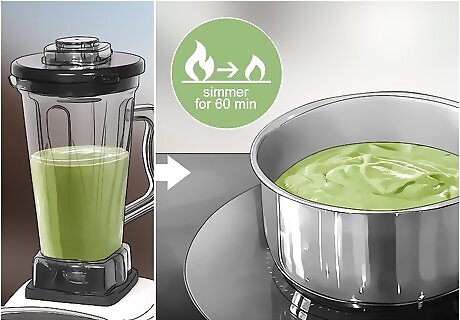
Simmer the pulp over very low heat for about an hour. Place the blended avocado pulp in a large sauce pan over the lowest possible heat on your stove. Use a simmer setting, if you can. Simmer the pulp for 40 to 60 minutes, or until it changes from pale green to dark green or brown. Stir the pulp frequently as it cooks, or it may stick to the sides of the pan and burn. You should begin to see the oil separating from the pulp and pooling at the top of the pan as you cook.
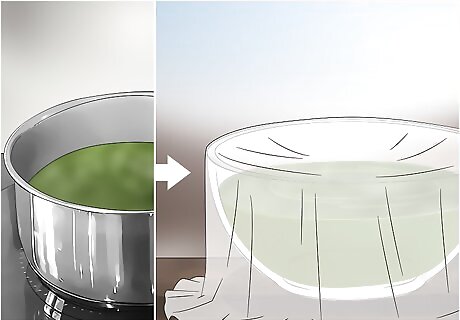
Scoop the mixture into a bowl and cover it with a muslin cloth. Once your oil is cooked, pour it into a heat-safe container, such as a metal or ceramic bowl. Drape a clean kitchen cloth made of a fine material, such as muslin or cheesecloth, over the top of the bowl. Since you will be squeezing the oil out of the cooked avocado pulp by hand, let the mixture sit for several minutes to cool down.
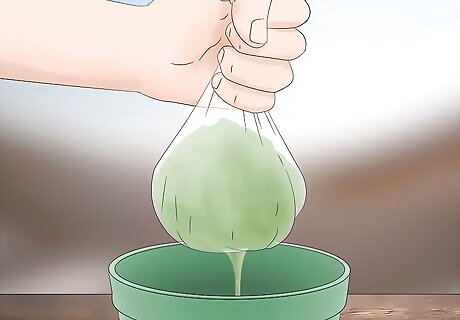
Squeeze the oil out of the cooked avocado through the cloth. Once the avocado pulp is cool enough to touch, flip the bowl over to transfer the pulp onto the cloth. Gather the edges together to create a bag, then squeeze the pulp through the cloth and let the oil run out. Squeeze the cloth over a clean bowl or directly over a storage container, such as a glass bottle or jar. The avocado oil should be a rich, emerald green color.
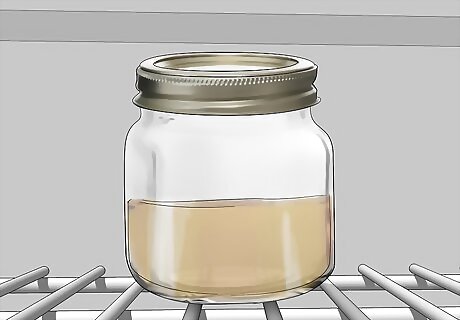
Store your oil in an airtight container in the refrigerator for up to a year. Put the oil in a container with an airtight lid or stopper, and store it away from light and heat. Avocado oil keeps best when stored in the refrigerator. Your avocado oil may become cloudy when it is chilled, but it should become clear again when it warms up to room temperature. If you don’t have an airtight container, use your avocado oil within 2 or 3 days. Fresh avocado oil should have a subtle, nutty smell. If your oil has gone bad, it will develop a strong, rancid smell and an unpleasant taste.
Extracting Oil from Coconut Milk
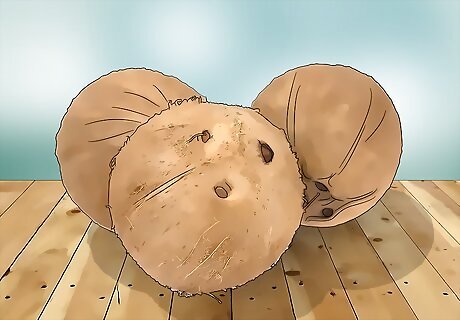
Choose 3 or 4 mature coconuts. Look for mature brown coconuts rather than young green ones, since older coconuts have thicker flesh and can yield more milk. 3 to 4 coconuts will produce about 4 cups (0.95 L) of milk, which will yield about 1.8 ounces (51 g) of oil. You can buy whole coconuts at many grocery stores, or order them online.
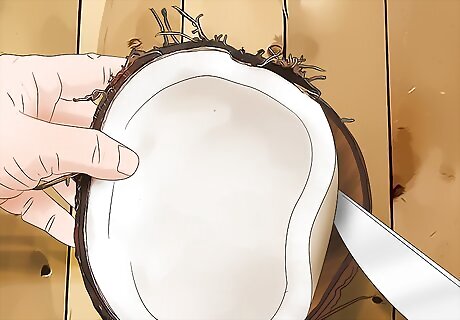
Remove the coconut meat from the shell. Break the hard shell of the coconut with a hammer or the back side of a heavy kitchen cleaver. Use a spoon or dull knife (such as a butter knife) to separate the meat inside from the shell. You can also buy specialized coconut knives that are designed to easily separate the meat from the shell. To avoid a mess, you may wish to puncture one of the eyes of the coconut and drain out the water before cracking the shell. Use a small knife to poke through the eye, or tap the tip of a screwdriver or a drill bit in with a hammer.

Grate the coconut meat. Once the meat is extracted, use a grater to shred the meat. Grate the coconut over a bowl or directly onto a piece of muslin cloth to easily collect the shreds. For easier shredding and grating, you can purchase a coconut shredder online or at a kitchen supply store. Some models are designed to shred the meat directly out of the shell.
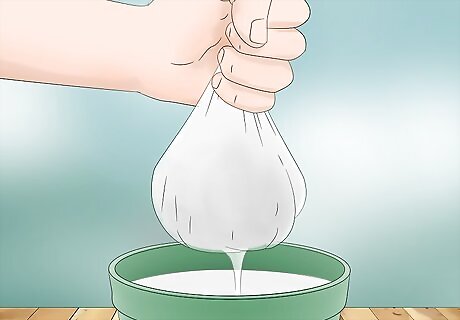
Squeeze the milk from the meat through a muslin cloth. Pile the shredded coconut onto a square of muslin cloth and pull the edges together to create a bag. Hold the bundle over a bowl and squeeze the cloth tightly with your hands to extract the milk. Adding a splash of hot water to the shreds may help the milk flow out more easily. If there are any particles in the milk, place a second piece of muslin cloth over a clean bowl or jar and sieve the milk through the cloth.
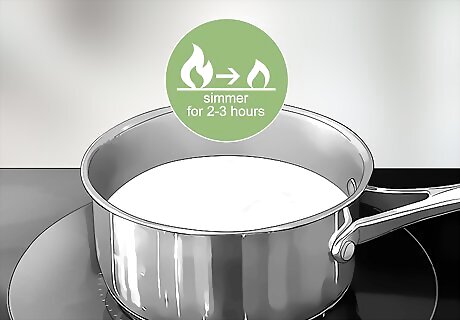
Simmer the milk over low heat for 2 to 3 hours. Pour the milk into a saucepan and place it on your stove on a simmer setting. Check the milk frequently and stir it to make sure it is not burning or sticking to the pot. Cook the milk uncovered until it turns slightly brown. To cook the coconut milk in a traditional Indian style, use a brass cooking pot called an urli. After the milk thickens and becomes light brown, remove it from the fire. Let it sit until it is cool enough to handle.

Squeeze the cooked milk through a muslin cloth. Once the coconut milk is cooked and cooled, it should become thick and creamy. Pour or spoon it onto a muslin cloth over a bowl or jar. Fold the cloth into a bag or bundle and squeeze it to release the oil into the bowl. If you wish, you can squeeze the oil directly into a storage container.
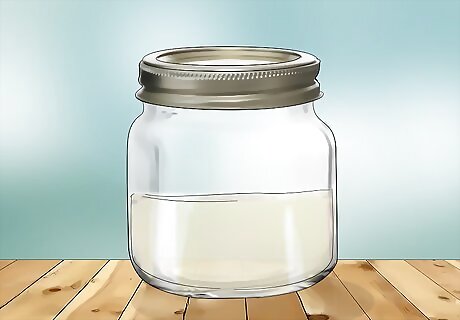
Store the oil in an airtight container for up to a year. Put your coconut oil in a container with an airtight lid, such as a bottle or storage jar. Keep it in a cool, dark area, such as your pantry or kitchen cabinet. Your coconut oil should stay good for about a year with proper storage. You can store your coconut oil in the refrigerator if you like, but it will become solid when it is chilled. You’ll have to warm the container up to room temperature in order to easily get the oil out. Coconut oil that has gone bad may appear yellowish or chunky, and it may develop a bitter or sour odor and taste. It may also develop black spots if it becomes contaminated with mold.



















Comments
0 comment